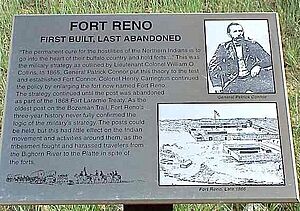Fort Reno (Wyoming) facts for kids
Quick facts for kids |
|
|
Fort Reno
|
|

Old Fort Reno
|
|
| Location | Johnson County, East of Sussex on Powder River |
|---|---|
| Nearest city | Sussex, Wyoming |
| Built | 1865 |
| Architectural style | Fort |
| NRHP reference No. | 70000672 |
| Added to NRHP | April 28, 1970 |
Fort Reno, also known as Fort Connor or Old Fort Reno, was a wooden fort built by the United States Army. It was set up on August 15, 1865, in what is now Johnson County, Wyoming. The fort's main purpose was to protect travelers on the Bozeman Trail from Native American tribes.
Contents
Building Fort Connor
In 1865, the United States Army launched the Powder River Expedition. A key goal was to build a fort on the Powder River. On August 1, 1865, a group of about 650 soldiers left Fort Laramie. This group was led by Colonel James H. Kidd and Brigadier General Patrick E. Connor.
The soldiers included cavalry units from California, Michigan, Ohio, and Iowa. There were also Pawnee Scouts and artillery soldiers with cannons.
On August 15, 1865, Colonel Kidd's group chose a spot for the fort. It was on a bluff above the Powder River, near where the Bozeman Trail crossed. Building started that same day. The fort was named Fort Connor, honoring General Patrick E. Connor.
Later that month, soldiers from Fort Connor fought in the Battle of the Tongue River. By September 25, 1865, all parts of the Powder River Expedition met at Fort Connor. Most of these soldiers then left for Fort Laramie to finish their service. Four companies of Michigan cavalry stayed behind to guard the fort.
Fort Reno's New Name
The Bozeman Trail was a path around the Bighorn Mountains. It crossed the Powder River at Fort Connor, offering safety to travelers. The buildings at Fort Connor had roofs made of sod and dirt floors.
In October 1865, the Michigan cavalry left the fort. Captain George W. Williford and his soldiers, known as "Galvanized Yankees", took over. These were former Confederate prisoners who joined the Union Army.
In November 1865, the fort's name was changed to Fort Reno. This was to honor Major General Jesse L. Reno, a Union Army officer. He was badly wounded in 1862 during the Battle of South Mountain. This Fort Reno is not connected to Major Marcus Reno, who fought in the Battle of the Little Bighorn.
The soldiers at the fort faced a very hard winter in 1865–1866. Many soldiers left, got sick, or died. Captain Williford also died from illness in April 1866. Captain George M. Bailey then became the new commander.
Making the Fort Stronger
On June 28, 1866, Colonel Henry B. Carrington arrived at Fort Reno with about 700 soldiers. These new soldiers were from the 18th U.S. Infantry. They took over from the "Galvanized Yankees." Colonel Carrington's group was moving into the Powder River Country to build more forts further north along the Bozeman Trail.
When Carrington arrived, only 104 of the original 137 "Galvanized Yankees" were left. Many had died from sickness. Colonel Carrington left three companies of the 18th Infantry to guard Fort Reno. He continued his march north on July 9, 1866.
The new soldiers built a strong log fence, called a stockade, around the fort's buildings. They also added log towers at the corners. They built a sturdy adobe building for the commanding officer. In 1867, the fort was improved and made bigger. The number of soldiers at the fort ranged from 125 to 300. These soldiers kept the southern part of the Bozeman Trail open and safe. They also had occasional fights with Native American warriors.
Fort Reno's End
In 1868, the Fort Laramie Treaty ended Red Cloud's War. This treaty gave the Powder River Country to the Lakota Sioux. As part of this agreement, Fort Reno was abandoned by the army in August. Soon after the soldiers left, Cheyenne warriors burned the entire fort.
During the Great Sioux War in 1876, Brigadier General George Crook and his 883 soldiers returned to the Fort Reno site. They found only some adobe walls and burnt remains. Crook used the site as a supply base for 15 days. He left some wagons and soldiers there. On March 5, Crook's soldiers fought Native American warriors in the Fort Reno Skirmish across the river. Later that year, the army again used the area as a supply base.
In the 1880s, the soldiers buried at Fort Reno were moved. They were reburied at the Custer Battlefield National Cemetery in Montana.
Soldiers at Fort Reno
Here are some of the groups of soldiers who were stationed at Fort Reno:
- August—October 1865: 6th Michigan Volunteer Cavalry
- October 1865—April 1866: 5th United States Volunteer Infantry
- April—June 1866: 5th United States Volunteer Infantry
- June—September 1866: 18th United States Infantry
- September 1866—August 1868: 27th United States Infantry
- March 1876: 4th United States Infantry
Fort Reno Today
Today, the area where Fort Reno stood looks like a natural prairie. The site is about 12 miles (19 km) northeast of Sussex, Wyoming. It was added to the National Register of Historic Places on March 28, 1970. There is a large stone monument and signs that explain the history of the site. You can reach it by a gravel road.
Other Forts Named Reno
Two other army posts were also named Fort Reno:
- One was Fort Reno Park in the defenses of Washington D.C. during the Civil War.
- Another frontier outpost called Fort Reno was built in 1874 in what is now Oklahoma.
Photo gallery
See also
 In Spanish: Fuerte Reno para niños
In Spanish: Fuerte Reno para niños








